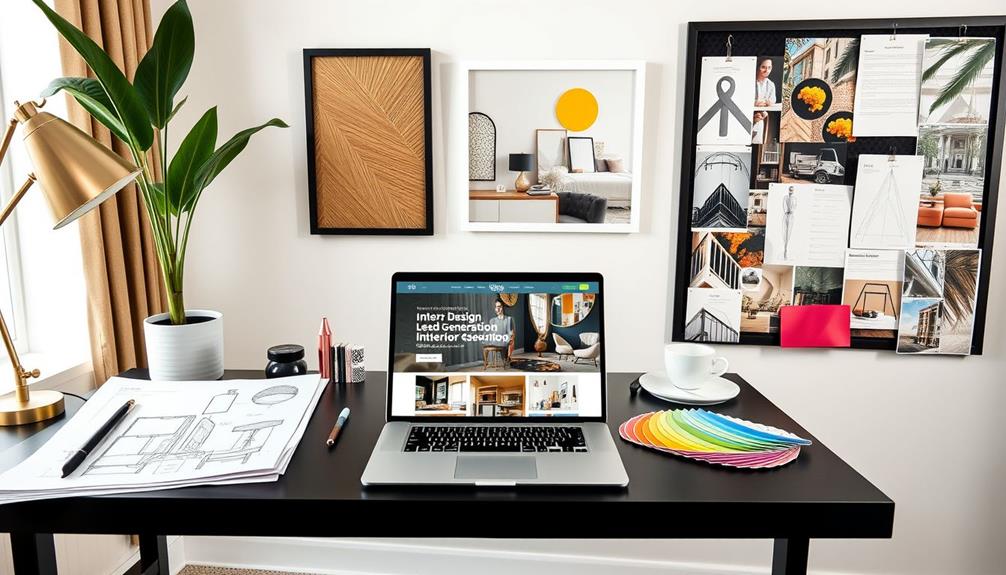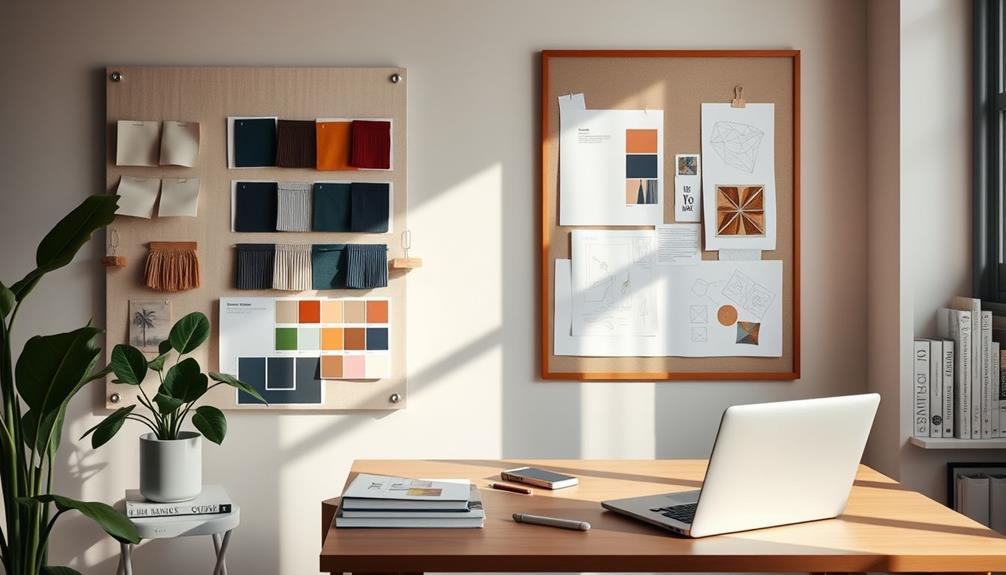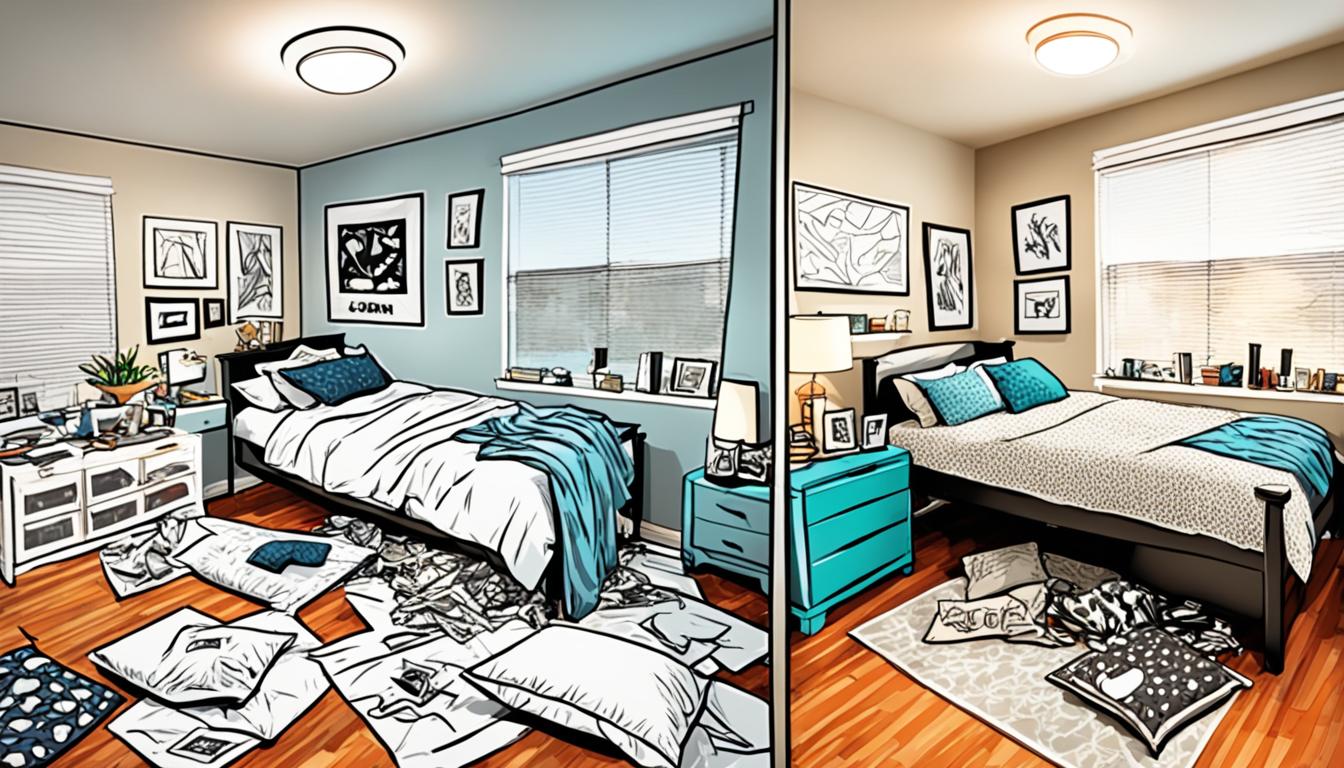To create an impressive interior design portfolio, start by showcasing your best work. Select 5-7 standout projects that reflect your unique style and versatility. Use high-quality visuals to capture attention—think sharp images and thoughtful staging. Incorporate your design process by including sketches and client briefs. Maintain consistency in branding with a unified color palette and typography. Don't forget to gather testimonials from satisfied clients to enhance credibility. Finally, promote your portfolio on social media and relevant platforms to increase visibility. Keep going, and you'll uncover more tips to elevate your portfolio even further. For even more impact, consider adding before-and-after shots to highlight your transformational abilities. Showcasing your attention to detail and problem-solving skills will enhance the presentation of your portfolio. These interior design presentation tips can help set you apart from the competition and attract potential clients.
Key Takeaways
- Choose between a digital or printed format for your portfolio to best showcase your unique style and skills.
- Select 5-7 of your strongest projects that demonstrate versatility and align with your desired client demographic.
- Include visual elements like sketches and mood boards to illustrate your design process and creativity effectively.
- Utilize high-quality images and maintain a cohesive color palette and typography for a professional presentation.
- Gather client testimonials to enhance credibility and showcase client satisfaction with your design work.
Importance of an Interior Design Portfolio
An interior design portfolio is imperative for any designer, acting as your professional showcase that highlights your unique style and skills. This interior designer portfolio not only allows you to show work but also establishes your identity in the competitive design industry. By showcasing a diverse range of projects and demonstrating your ability to work with different design styles, a well-curated interior design portfolio can help you attract potential clients and employers. Additionally, staying updated with the latest trends and techniques through interior design courses online can further enhance your portfolio and set you apart in the industry. Taking advantage of online courses can also demonstrate your commitment to continuous learning and improvement, adding value to your portfolio.
By creating a well-constructed professional portfolio, you can effectively differentiate yourself from other designers, making it easier for potential clients to recognize your value. Including a diverse body of work demonstrates your versatility and adaptability across various styles and client preferences.
This variety is essential since design firms often seek designers who can cater to different tastes and project demands. Additionally, a strong portfolio provides tangible evidence of your capabilities, showcasing real-world project experience that enhances your credibility.
Regularly updating your portfolio guarantees it stays relevant and engaging, reflecting your growth and the evolution of your design philosophy over time. This ongoing refinement is critical for attracting potential clients, as it shows that you're not just stagnant but actively developing your skills and style.
An impressive interior designer portfolio can greatly enhance your chances of securing projects or employment in this dynamic field.
Choosing the Right Format

Choosing the right portfolio format is essential for showcasing your work effectively. You've got a couple of solid options: a digital portfolio or a printed version.
Digital options, like a portfolio website, offer convenience and accessibility across devices, making it easy to share your work with potential clients. Plus, you can regularly update it to reflect your latest design skills and projects.
On the other hand, a printed version can create a tangible experience that leaves a lasting impression during in-person meetings. To enhance this, consider adding QR codes that link to your digital content, blending both formats.
Whichever format you choose, aim for a visually cohesive presentation that aligns with your design style and branding. Your portfolio should reflect your professionalism and unique aesthetic.
Digital portfolios also allow for interactive features like videos or animations, which can engage viewers more than static images in a printed version.
Selecting Your Best Work

When selecting your best work for your interior design portfolio, focus on quality over quantity. Aim to choose 5-7 of your strongest projects that truly represent your design style and skills. This selection guarantees clarity and impact, vital for a successful interior design portfolio.
Make certain each project showcases a range of your capabilities, including various design styles and types of spaces, like residential and commercial. Highlight projects that demonstrate successful outcomes, such as client satisfaction, awards, or features in publications. These elements not only add credibility but also underline your achievements.
Tailor your selections to align with the type of work or clients you want to attract. For instance, if you're targeting contemporary residential projects, emphasize modern designs. This strategic approach helps you connect with potential clients who resonate with your aesthetic.
Lastly, don't forget to regularly assess and update your portfolio. Replace outdated or less impressive work with new projects that reflect your evolving skills and design philosophy.
Showcasing Your Design Process

Showcasing your design process can greatly enhance your interior design portfolio by providing potential clients with insight into your creativity and problem-solving abilities.
Start by including visual elements like sketches, mood boards, and color schemes that illustrate your creative journey for each design project. These visuals speak volumes and help show people how you arrived at your final design choices.
Present client briefs succinctly, outlining the project goals and the challenges you faced along the way.
Document the design evolution by showcasing various stages of your work, from initial concepts to final renders or photographs. This not only highlights your problem-solving skills but also reflects your adaptability throughout the process.
Accompany your visuals with concise descriptions that narrate each project's story, emphasizing key design choices and the rationale behind them.
Don't forget to incorporate feedback from clients to demonstrate your responsiveness to their needs and preferences.
Utilizing High-Quality Visuals
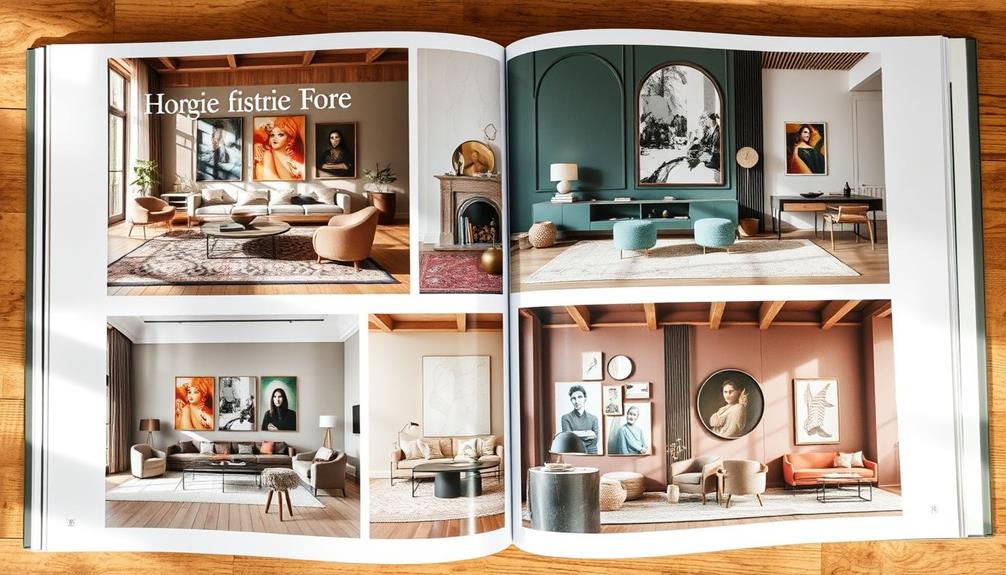
When you're building your interior design portfolio, the quality of your visuals is essential. High-quality images not only showcase your work effectively but also enhance your credibility as a designer.
Importance of Visual Quality
High-quality visuals are essential for any interior design portfolio, as they not only enhance the overall appeal but also build trust with potential clients and employers. When you present your work with professional imagery, you establish credibility that's vital in this competitive field.
Research shows that portfolios featuring high-quality visuals can lead to a 60% higher engagement rate from potential clients, making it clear that the effort pays off.
Incorporating a variety of visual formats, like 3D renderings, hand sketches, and mood boards, creates a dynamic narrative that showcases your creative process and unique style.
Proper lighting and staging in your photographs will elevate the aesthetic appeal of your portfolio pieces, ensuring they're more attractive and memorable to viewers.
Techniques for Capturing Images
Capturing stunning images of your interior design work requires attention to detail and a bit of strategy. Start by using a high-resolution camera or a quality smartphone to guarantee your photographs are sharp and detailed.
Lighting plays a vital role, so aim to shoot during the day when natural light floods the space. If harsh shadows appear, consider using reflectors or diffusers to soften them.
Before you snap those photos, staging is essential. Declutter the area and thoughtfully arrange furniture to create an inviting composition. This makes a significant difference in how your work is perceived.
Don't hesitate to experiment with different angles and perspectives. Eye-level shots can capture intimacy, while wide-angle views showcase the full scope of your design and highlight unique features.
After taking your images, don't forget the editing process. Use software like Adobe Lightroom or Photoshop to enhance brightness, contrast, and color accuracy.
This will improve the overall visual appeal of your portfolio without misrepresenting the actual design. By incorporating these techniques, you'll create a polished and professional collection of images that truly reflect your interior design expertise.
Emphasizing White Space
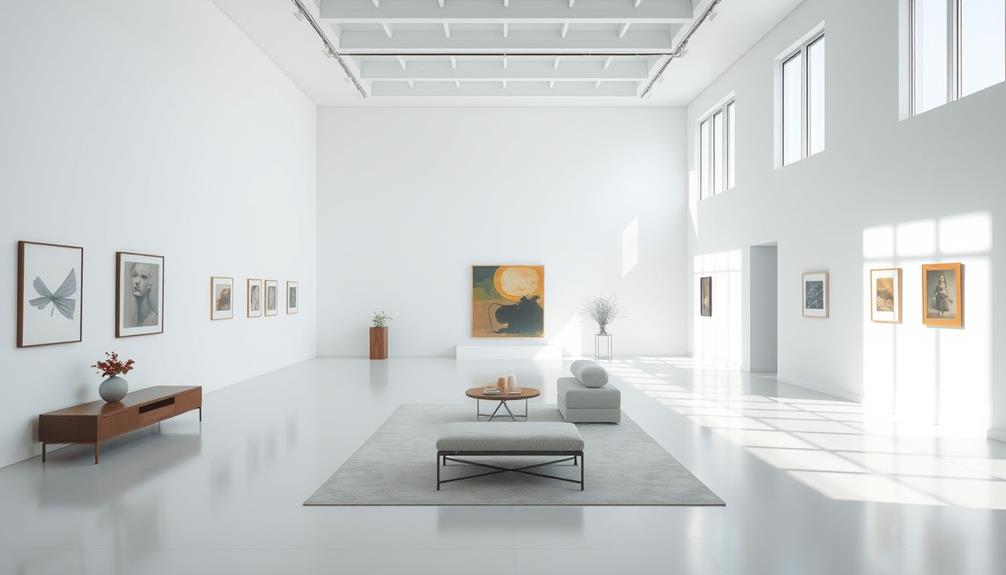
In the world of interior design portfolios, emphasizing white space can greatly enhance the viewer's experience. By incorporating adequate white space, you create a balanced layout that improves visual flow and keeps your portfolio from feeling cluttered.
This breathing room allows key visuals to stand out, drawing attention to your standout projects and enhancing their quality and significance.
Consider these elements of effective white space:
- Breathing Room: Space between images and text allows viewers to focus without feeling overwhelmed.
- Dramatic Emphasis: Intentionally left empty sections can highlight the surrounding content, giving it a professional appearance.
- Guided Engagement: A well-structured layout makes it easier for viewers to absorb information and explore your design narrative.
Consistency in Branding
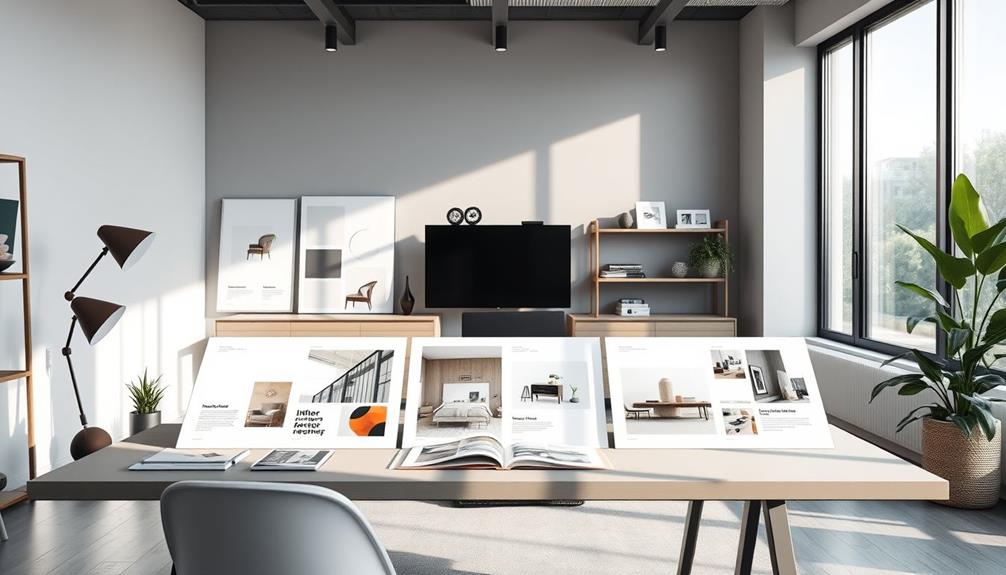
When creating your interior design portfolio, consistency in branding is key to showcasing your unique style.
By using a cohesive color palette and maintaining font consistency, you'll create a unified visual aesthetic that resonates with potential clients.
This attention to detail not only enhances recognition but also reinforces your professional identity.
Unified Visual Aesthetics
Creating a strong and unified visual aesthetic in your interior design portfolio sets you apart and helps potential clients connect with your unique style. To achieve this, focus on establishing a consistent layout and branding that reflects your design philosophy.
It's crucial to use a unified color palette, typography, and imagery style throughout your portfolio. This cohesion not only enhances the visual theme but also makes your work more memorable.
Consider incorporating the following elements:
- A signature logo that represents your brand identity
- A harmonious blend of fonts that convey your design ethos
- Consistent project layouts that guide the viewer's eye effortlessly
When you maintain a polished overall look, it reinforces your professionalism. Regularly updating your portfolio while adhering to your established branding guidelines guarantees that new projects align with your evolving style, creating a seamless experience for your audience.
This consistency in branding allows potential clients and employers to easily recognize and appreciate the specific styles you bring to life in your designs.
Cohesive Color Palette
A cohesive color palette is essential for establishing a strong visual identity in your interior design portfolio. By choosing a limited color scheme of 3-5 colors that reflect your personal style and align with your design philosophy, you'll maintain harmony across all elements of your portfolio. This consistency enhances brand recognition and professionalism.
Utilizing color psychology is vital; warm tones can evoke feelings of comfort and energy, while cool tones promote calmness and sophistication. Select colors that resonate with the emotions you want your designs to convey.
Apply your chosen color palette consistently across images, typography, and layout. This creates a seamless experience for viewers, reinforcing your branding and making your portfolio more memorable.
Regularly evaluate your color choices against current design trends to keep your portfolio fresh and visually appealing, while still maintaining that cohesive theme.
Font Consistency
Color choices lay the foundation for your portfolio's visual appeal, but font consistency plays a vital role in solidifying your brand identity. By maintaining a cohesive typography style throughout your portfolio, you enhance your professionalism and make it easier for potential clients to recognize your work.
To achieve effective font consistency, consider the following:
- Limit your font types to two or three that complement each other, aligning with your overall design theme.
- Establish a clear visual hierarchy by using specific font weights and sizes. Distinguish headings, subheadings, and body text to improve readability.
- Select fonts that embody your design philosophy, reflecting your creative personality and innovation.
Consistent typography creates a cohesive narrative, allowing your stunning designs to take center stage without distraction from varying text styles.
This approach not only elevates your portfolio but also leaves a memorable impression on potential employers and clients. Ultimately, font consistency is more than just aesthetics; it's a vital aspect of your branding strategy that communicates your unique style and professionalism in the competitive field of interior design.
Effective Typography Choices

Typography serves as the backbone of your interior design portfolio, influencing how your work is perceived. To create a clean and professional appearance, limit yourself to two or three font families. This keeps the viewer focused and avoids overwhelming them.
For headings, opt for sans-serif fonts to establish a modern and approachable vibe. In contrast, serif fonts can lend elegance to your body text.
Next, maintain a clear visual hierarchy by using readable font sizes—typically between 10-12 points for body text and 16-24 points for headings. This guarantees your portfolio remains easy to navigate. Incorporate varying font weights, such as bold for emphasis and regular or light for body text, to create contrast and highlight important information effectively.
Lastly, don't overlook consistent spacing and alignment across text elements. This enhances overall readability and visual structure, allowing your design work to take center stage.
Gathering Testimonials and Feedback
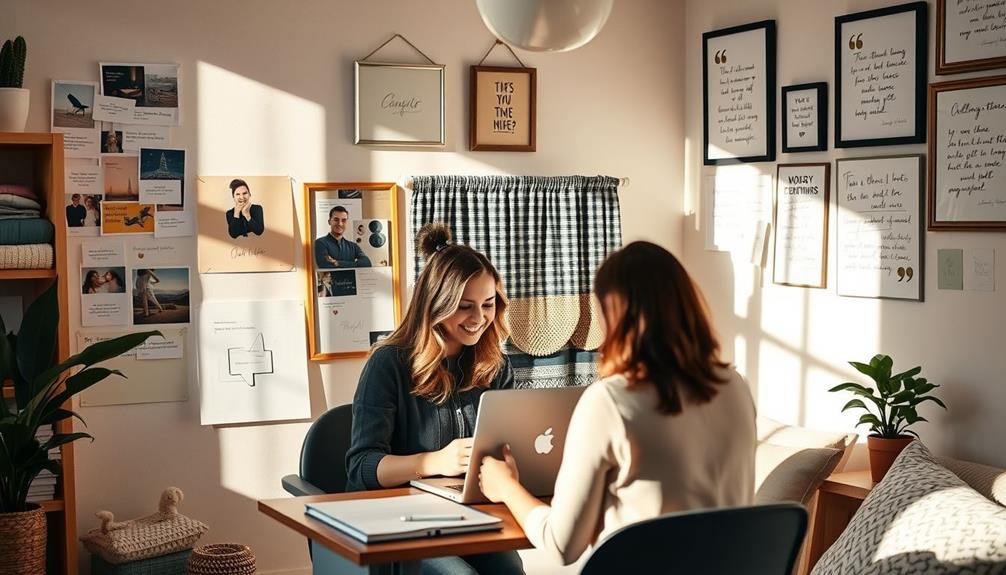
Gathering testimonials and feedback is essential for showcasing your credibility and attracting new clients.
Start by actively requesting endorsements from satisfied clients after completing a project, as these recommendations can considerably boost your portfolio's appeal.
Additionally, consider using platforms like LinkedIn to collect and display these testimonials, enhancing your professional image.
Importance of Endorsements
Endorsements play an essential role in shaping the perception of your interior design portfolio. When potential clients see testimonials and client feedback, they're more likely to trust your work and feel confident in your unique design elements.
With 79% of consumers trusting online reviews as much as personal recommendations, showcasing positive endorsements can greatly enhance your portfolio appeal.
- Imagine a client raving about their stunning new living room, transforming a house into a home.
- Picture a peer highlighting your innovative approach to sustainable design, making your work stand out.
- Visualize a satisfied customer sharing how your expertise exceeded their expectations, reinforcing your professional development.
Incorporating these testimonials into your portfolio not only attracts new clients but also demonstrates your commitment to quality and ongoing improvement.
Regularly updating your portfolio with fresh feedback keeps it relevant and engaging. Plus, showcasing endorsements that align with specific design styles can resonate with potential clients, as 85% prefer seeing previous work that matches their needs.
Strategies for Collecting Testimonials
Collecting testimonials can greatly boost your interior design portfolio's credibility and appeal. To maximize your chances of receiving valuable feedback, actively solicit testimonials from clients right after project completion; about 70% of clients are likely to respond positively when asked directly.
Utilize follow-up emails or feedback forms with specific questions that highlight your strengths and services. This structured approach makes it easier for clients to articulate their experiences. Incorporate the testimonials into your portfolio alongside relevant project images, as this visual context enhances the impact of client feedback.
Don't forget to leverage social media platforms. Request public testimonials from satisfied clients; this not only increases your online credibility but also encourages others to share their positive experiences.
Lastly, make it a habit to regularly update your portfolio with fresh testimonials. This keeps your work relevant and demonstrates ongoing client satisfaction.
Here's how to organize your testimonials effectively:
| Client Name | Testimonial |
|---|---|
| Jane Doe | "Transformed my space beautifully!" |
| John Smith | "Professional and creative!" |
| Emily Clark | "Exceeded my expectations!" |
| Mark Lee | "I love my new interior!" |
Sharing and Promoting Your Portfolio

Effective promotion of your interior design portfolio is essential for attracting clients and showcasing your unique style. Start by utilizing social media platforms like Instagram and Pinterest to visually share your work. These platforms allow you to reach a broader audience and engage potential clients through engaging posts and stories.
Furthermore, consider leveraging resources like the community engagement features available through architectural services, which can enhance your visibility in the industry.
Here are some effective strategies for sharing and promoting your portfolio:
- Create a personal website: Host your online portfolio and optimize it for search engines with relevant keywords to enhance visibility.
- Use design-centric platforms: Share your portfolio on sites like Behance and Houzz, which cater to interior design professionals, allowing you to network and connect with potential clients.
- Attend industry events: Engage in workshops and networking events to share your portfolio in person, making lasting impressions and establishing valuable connections.
Additionally, consider using cloud storage services like Google Drive or Dropbox. This way, you can seamlessly share your portfolio with potential clients and collaborators, ensuring quick access to your work.
Conclusion
In crafting your interior design portfolio, you're not just showcasing your work; you're curating a narrative that reflects your unique vision and style. By thoughtfully selecting pieces and presenting them with clarity and flair, you invite potential clients into your creative world. Remember, this portfolio is your calling card, a subtle whisper of your capabilities. Embrace the journey of promotion, and let your artistry speak volumes, ultimately drawing in those who appreciate your refined aesthetic.
